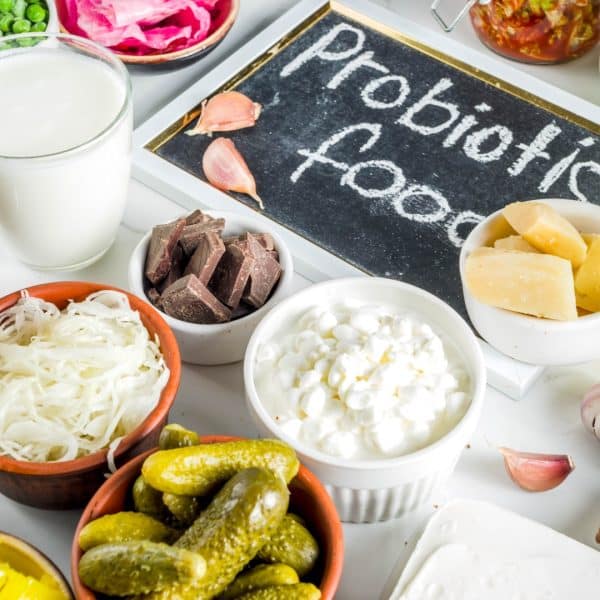Are you interested in gut health and all the buzz surrounding prebiotics and probiotics? You’re not alone! With so much information out there about these two topics, it can be overwhelming to understand the difference between the two.
Our body naturally contains a community of good bacteria to fend off the bad bacteria that routinely find their way into our system. We need the good stuff as part of our digestive and immune armies.
But today, there’s a lot of hype and just plain bad products and foods being promoted for their good bacteria. Confusing, right?
No worries, I’m gonna break it all down for you today. In this blog post, we’ll take a deep dive into the prebiotics/probiotics pool so you can learn what makes these little guys so special. Let’s get started!

Prebiotics
What Are Prebiotics And Why Do You Need Them
You hear a lot about probiotics – those gut-friendly bacteria that we find in yogurt and fermented foods. But what about prebiotics? These can be just as important for your digestive health and believe it not…your mood! So what are they exactly?
Prebiotics are non-digestible substrates, such as resistant starches, that act as fuel for a probiotic. Think of it as food that you don’t eat, but is used by our good probiotics to have a beneficial effect on us, our gut health, and as a result, our overall health.
They help us to maintain a better balance of good bacteria, which ultimately keeps our digestive and immune systems running better.
Poor gut health can keep you from your better health, and better mood! Prebiotics are part of your better nutrition to strengthen your gut health and in doing so promote a healthy inflammatory response, and healthy hormones, plus enable mental well-being.
But Where Can You Find Prebiotics
They are often found in resistant starches, which pass through our digestive system and selectively fuel our good gut bacteria.
Examples of foods that are potent in resistant starches are potato starch (non-modified), uncooked oats, Jerusalem artichoke, chicory, and green banana and they can develop from cooked then cooled pasta.
Yeah, you heard right — I said potato and pasta! And although these foods are pretty rarely listed when talking about nutrition and health, they can be helpful in the context of prebiotics.
And, when we consume them in their prebiotic-rich form, we don’t take in all the calories for energy as many are used by our gut bacteria.
Now this doesn’t mean you can go eat bowlfuls of cooked and cooled pasta or mountains of potatoes – your good gut bacteria don’t have that big of an appetite.
Portions still need to be better, choices still need to be better quality, and they still count as carbs when you balance your nutrients so pair them with proteins, fats, and non-starchy vegetables.
And yes, I said green banana too! Along with cooked and cooled pasta and uncooked oats, green banana (the unripe banana) delivers prebiotics.
Since the flavor or texture of an unripe banana isn’t the most appealing, the flour can be used and varies from 35 – 68% resistant starch.
Just be careful of the baking flour as cooking it will lower the amount of resistant starch you are consuming. Try having it raw in a smoothie or protein bowl.
How Much Do You Need
This all depends on the type of prebiotic you are having. 1-2 grams of certain prebiotics, known as xylooligosaccharides, can be enough to get a bifidogenic effect (meaning helping to feed bifidobacterium, one kind of probiotic).
These can be found in bamboo shoots, fruits, vegetables, milk, and honey. Other types, known as isomaltooligosaccharides, may require at least 30 grams a day to get beneficial prebiotic effects.
Start introducing slowly, journal the kinds, amounts, and reactions, and make sure to get in enough water.
Also, keep in mind that prebiotics should be taken with probiotics – you want to establish good bacteria from probiotics so you have something to fuel through your prebiotics.
When Are Prebiotics Contraindicated
If you suffer from IBS or Inflammatory Bowel Disease, prebiotics often falls under those high FODMAP foods that may irritate symptoms, especially in the early stages of restoring better bacteria balance. For any digestive health issues, discuss prebiotics with your practitioner!

Probiotics
What Are Probiotics
Probiotics are microorganisms that are believed to provide health benefits when consumed. The term probiotic is currently used to name ingested microorganisms associated with benefits for humans and animals.
The World Health Organization’s (WHO) 2001 definition of probiotics is “live micro-organisms which, when administered in adequate amounts, confer a health benefit on the host.”
Why Do You Need Probiotics
We are all individuals – from our fingerprints to our DNA to our microbiome – and as such none of us have the exact same microbes existing in our microbiome at any specific moment.
Probiotics – good bacteria – are meant to inhabit our entire digestive tract at approximately 80:20 ratio with bad bacteria. There will be and we should be okay with there always being some bad bacteria in the digestive tract.
But if the balance is upset, we see an increased risk for digestive problems, impaired immune system, and skin problems (resulting from digestive disturbances – our skin is our other major excretory organ and remember stuff that’s meant to get out of the body will find a way to get out!), and other potential health issues.
Where Can You Find Probiotics
Probiotics are live microbes. They need to be living when they are consumed and they need food, as well as a nourishing environment to survive and thrive (the goal of consuming them).
Probiotics can be found naturally in cultured (fermented) foods as well as added to foods and sold as isolated dietary supplements.
Reliable food sources of probiotics included fermented foods such as kimchi, raw sauerkraut, pickles, miso /natto, cultured vegetables, dairy and non-dairy sources of yogurts, cheeses, kombucha, and kefirs.
Today, foods can be fortified with probiotics too. This can make them a good source (if the strain, quantity, and probiotics are guaranteed to be ‘live and active’ when you consume them (not when the product first gets to the store).
Probiotics set up shop and get to work, and you will likely notice the difference. Patients starting on a probiotic – whether a supplement or adding probiotic-rich foods – often comment that they feel different or notice it in their digestive system.
Start with a smaller dose and do it in as much of a controlled setting as possible (not on a travel day or when giving a talk in front of a crowd or sitting quietly through a full-day meeting for example).
Strain specificity matters – different probiotics do different things (think apples and oranges – they are both fruits, and both provide quick energy from carbs as well as offer fiber, but their plant nutrients (phytonutrients) support different body functions better).
Some probiotics are better for addressing loose stools or traveler’s diarrhea, whereas others may help support the immune functions of the digestive tract, and others may address constipation and bloating.
The quality of the probiotic and its match to what your body needs makes all the difference as to whether it helps or can even harm. Probiotics don’t work alone.
They need to be fed (prebiotics), and comfortable (alkaline environment), and they need help staying where they should be (glutamine, colostrum to support healthy gut lining).
Thus, prebiotics and probiotics have a sort of symbiotic relationship in that they need each other to work best.
Are There Any Potential Issues With Probiotics
Well, there are a few things you need to be aware of when using probiotics.
- Fermented foods naturally contain different amounts of probiotics.
- Fortified foods may not contain a proven strain or dose of a probiotic.
- Fermented, fortified foods & supplements often don’t contain bifidobacteria which is an essential probiotic for gut and immune health.
- Foods and supplements that promote their “probiotics” may have non-promotable, not better ingredients or amounts of added sugars, etc.
Conclusion: Prebiotics and Probiotics
Prebiotics and Probiotics are both essential players in our gut health.
Think of prebiotics as the hardworking farmers, planting the seeds for a healthy microbiome, while probiotics are the savvy city slickers, managing and maintaining the delicate balance of bacteria.
So, next time you’re staring at a shelf full of supplements, don’t be daunted. Remember, with prebiotics and probiotics in your corner, your gut will be flourishing faster than you can say “I’m regular as a Swiss clockmaker.”
Feel like you need more personalized guidance in managing your chronic autoimmune issues? My 3-Month Signature Coaching Package may be just what you need to get started on the path to better health.
I’d be honored to work with you in developing your nutrition plan.
***Disclaimer: This post is for informational purposes only and should not be construed as medical advice***


